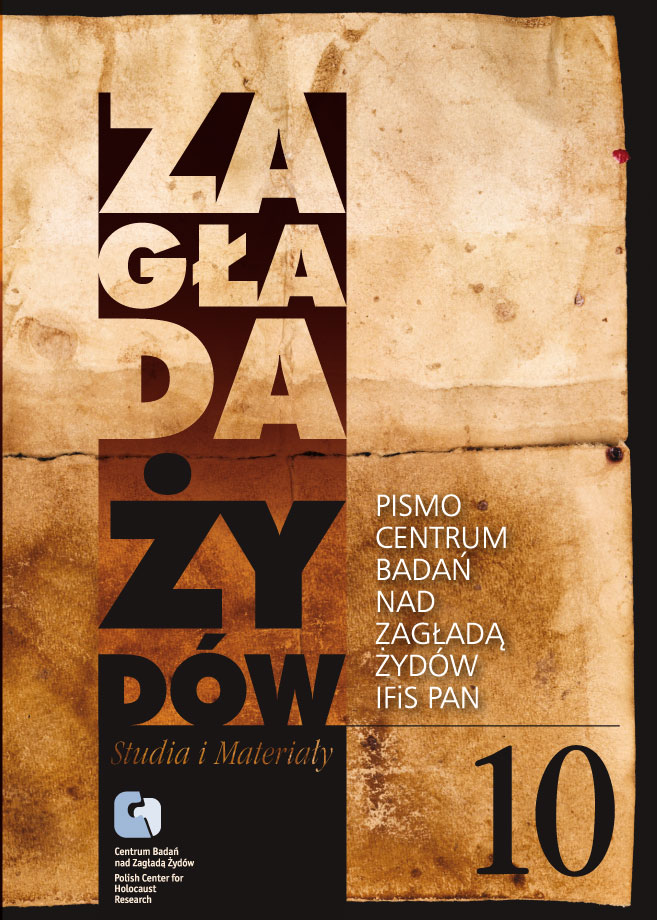Józef Kermisz (1907–2005) – twórca badań nad Szoa
Zagłada Żydów. Studia i Materiały, Nr 10 (2014), Strony: 304-316
Data zgłoszenia: 2020-10-22Data publikacji: 2014-12-01
 https://doi.org/10.32927/ZZSiM.526
https://doi.org/10.32927/ZZSiM.526
Abstrakt
Józef Kermisz (1907–2005) was a historian and an archivist who helped lay the foundations for Shoah research in Poland and Israel. In 1944 joined the Central Jewish Historical Commission where became the chief archivist. Since then his life has been devoted to retrieving wartime archival material. As archive director (in the Jewish Historical Institute in Poland and at Yad Vashem in Israel) he sought to develop an archive both for future historical research and for trials of suspected war criminal. He played a major role in discovering and preserving important documentation on the Shoah in Poland. Among his major professional achievements were preparing documentation for the prosecution in the Eichmann trial, and publishing Czerniakow’s diary and the full edition of the underground press of the Warsaw ghetto. He was one of the world’s leading experts on the Ringelblum Archive and other hidden Jewish documentation from the Holocaust. Kermisz left behind a legacy of a vast research infrastructure that he created and that will occupy scholars for generations.
Licencja
Prawa autorskie (c) 2014 Autor&"Zagłada Żydów. Studia i Materiały"

Utwór dostępny jest na licencji Creative Commons Uznanie autorstwa 4.0 Międzynarodowe.
https://creativecommons.org/licenses/by/4.0
Czasopismo publikowane jest w standardzie Diamond Open Access na licencji CC-BY-4.0 Deed - Uznanie autorstwa 4.0 Międzynarodowa - Creative Commons
Inne teksty tego samego autora
- Avner Shalev, Dan Michman, David Silberklang, Ścisła pamięć o Zagładzie w Muzeum Historii Holokaustu w Yad Vashem. Odpowiedź na artykuł Amosa Goldberga , Zagłada Żydów. Studia i Materiały: Nr 7 (2011)
Podobne artykuły
- Aleksandra Kasznik-Christian, Sprawa Marty Puretz, domniemanej agentki Gestapo z krakowskiego getta , Zagłada Żydów. Studia i Materiały: Nr 16 (2020)
- Michael Phayer, „Udzielanie pomocy Żydom nie jest rzeczą łatwą”. Polityka Watykanu wobec Zagłady – ciągłość czy zmiana? , Zagłada Żydów. Studia i Materiały: Nr 5 (2009)
- Jacek Walicki, Wydział Archiwum getta łódzkiego a Archiwum Ringelbluma , Zagłada Żydów. Studia i Materiały: Nr 16 (2020)
- Marek Kornat, Papież Pius XII i jego koncepcja „neutralności absolutnej” Stolicy Apostolskiej w stosunkach międzynarodowych (1939—1945). Przypadek Polski , Zagłada Żydów. Studia i Materiały: Nr 5 (2009)
- Grzegorz Krzywiec, Nadwiślański Weininger? Przypadki Juliana Unszlichta (1883–1953) , Zagłada Żydów. Studia i Materiały: Nr 5 (2009)
- Paweł Kosewski, Pamięć o Holokauście w kinie fabularnym (analiza retrospekcji filmowej, na podstawie filmów Pasażerka i The Pawnbroker) , Zagłada Żydów. Studia i Materiały: Nr 5 (2009)
- Marta Zawodna, O porządkowaniu poobozowego świata. Sposoby postępowania ze szczątkami ludzkimi na terenach byłego KL Auschwitz-Birkenau od momentu ostatecznej ewakuacji obozu do powstania muzeum , Zagłada Żydów. Studia i Materiały: Nr 8 (2012)
- Anna Ziółkowska, Medycyna obozowa. O tym jak chorowali, cierpieli i umierali żydowscy robotnicy w obozach pracy przymusowej w Poznaniu (1941–1943) , Zagłada Żydów. Studia i Materiały: Nr 8 (2012)
- Paweł Wolski, Tekst – autor – świadectwo. Na marginesie lektury Patrzyłam na usta… Dziennik z warszawskiego getta , Zagłada Żydów. Studia i Materiały: Nr 5 (2009)
- Dagmara Swałtek, Listy Gusty Ehrlich , Zagłada Żydów. Studia i Materiały: Nr 5 (2009)
<< < 43 44 45 46 47 48 49 50 51 52 53 54 55 56 57 58 59 60 61 62 63 64 65 66 67 68 69 70 71 > >>
Możesz również Rozpocznij zaawansowane wyszukiwanie podobieństw dla tego artykułu.
 English
English
 Język Polski
Język Polski




